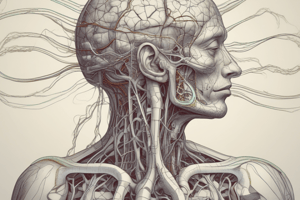Podcast
Questions and Answers
What percentage of the body's resting cardiac output does the brain receive?
What percentage of the body's resting cardiac output does the brain receive?
- 15% (correct)
- 20%
- 5%
- 10%
What is the consequence of interruption of cerebral blood flow for just a few seconds?
What is the consequence of interruption of cerebral blood flow for just a few seconds?
- No noticeable effect
- Mild headache
- Dizziness
- Temporary unconsciousness (correct)
Which arteries join to form the basilar artery that then splits to form the two posterior cerebral arteries?
Which arteries join to form the basilar artery that then splits to form the two posterior cerebral arteries?
- Vertebral arteries (correct)
- Anterior cerebral arteries
- Middle cerebral arteries
- Internal carotid arteries
Which type of arteries provide collateral circulation in the brain if a distributing artery becomes occluded?
Which type of arteries provide collateral circulation in the brain if a distributing artery becomes occluded?
What is the characteristic feature of the blood-brain barrier?
What is the characteristic feature of the blood-brain barrier?
Where do nearly all of the venous blood from the brain leave the cranium?
Where do nearly all of the venous blood from the brain leave the cranium?
What primarily governs vasomotor activity in the brain?
What primarily governs vasomotor activity in the brain?
How does lowering arterial pH at a constant PCO2 affect cerebral blood flow?
How does lowering arterial pH at a constant PCO2 affect cerebral blood flow?
What is the effect of hyperventilation on cerebral blood flow?
What is the effect of hyperventilation on cerebral blood flow?
What is the Monro-Kellie doctrine related to?
What is the Monro-Kellie doctrine related to?
Flashcards are hidden until you start studying




